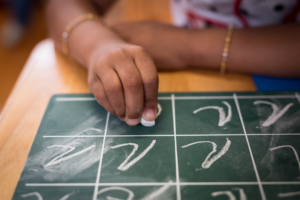By Tara Israelson – Nīkau Head Teacher – Preschool
In Montessori schools around the world teachers are often asked “why cursive?”. This is an excellent question, and, as we see more and more schools deciding not to teach cursive at all, it can feel like Montessori is stuck in a different time period. Well, perhaps this is slightly true if we go back to the genesis of Montessori philosophy. At the time of the first Casa dei Bambini in Italy in 1907, Dr. Montessori naturally chose to use cursive because it was the smoothest and least complicated style of writing to introduce to budding writers.
Montessori writes in The Discovery of the Child “Let us observe the spontaneous drawing of children when, for example, they are drawing lines on the sand of a garden path with a fallen branch. We shall never see them draw short straight lines, but long curved ones variously interlaced.” (p 194). This type of writing involves whole arm movements in shapes such as circles and loops which children the world over include in their creative art.
The continuity of the pencil strokes are also attractive to the child who is still exploring with the writing instrument, almost as an extension of their artistic exploration. This method of writing also requires less energy from the writer as they “run” the pen/pencil across the page without ever needing to lift it up or think about where the next line or circle is meant to go. Consider the letter ‘k’. In cursive this letter is almost like a bow you would find on a gift, all loops and curls. In print the writer must create a line and then accurately decide where the next two lines are going to go. The beginning writer does not need this distraction when what they are craving is the flow of getting the words out on paper.
Cursive letters also have an obvious beginning and end which makes it difficult to reverse the letters. The fluid pattern learned becomes ingrained in muscular memory. It is also obvious where a word begins and ends, making it easier to write stories. We find that once our young writers begin linking their letters together it is much easier for them to naturally include space between the words. As the child begins to write, and gets immersed in the flow of their ideas and thoughts, the ability to expend less effort on the mechanics of writing and more on this flow makes cursive the obvious choice. And, while cursive writing does harken back to the early days of Montessori, there is current research into its benefits and how using cursive writing is actually good for the brain. In fact, “accumulating evidence suggests that not learning cursive handwriting may hinder the brain’s optimum potential to learn and remember.” (Psychology Today, 2020).
As adults, we are more likely to be using tablets, phones and computers for our communication and perhaps for some of us cursive handwriting feels like a challenge. If you are interested in refreshing your cursive skills, or if you want to support your child as they begin their journey as a writer (or if you want to decipher what they have written) we have many tutorials to share so just stop in and ask!
If you would like to investigate the current research further here is a useful link https://www.psychologytoday.com/nz/blog/the-athletes-way/202010/why-cursive-handwriting-is-good-your-brain.
